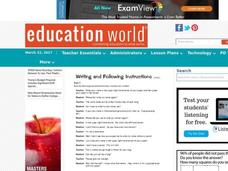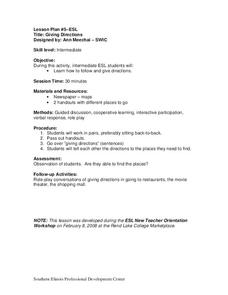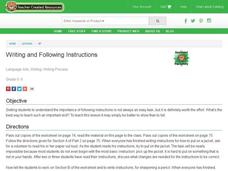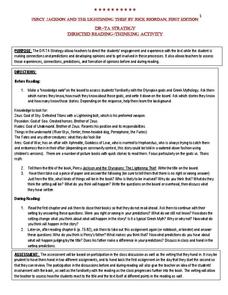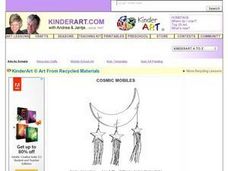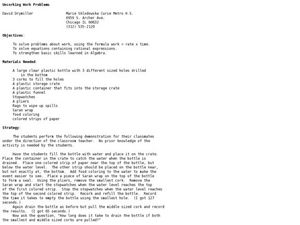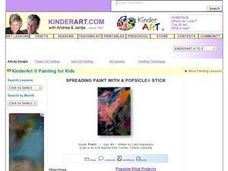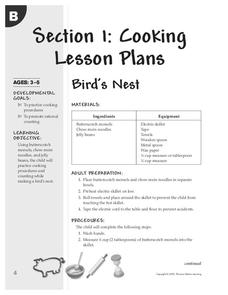Curated OER
Origami Ducks: Geometry, Listening, and Following Directions
Make origami ducks with your class to reinforce geometry concepts and vocabulary; develop fine motor and visual translation skills; and enrich study of Japanese culture, the pond habitat, or migration. Create a whole group "worksheet"...
Curated OER
Fun Food Faces
Students create tasty faces. In this food lesson, students use rice cakes to make a funny face. Students follow directions and use creativity for this activity. Students make a list of things they need from the grocery store to make more...
Curated OER
Co-Operation: Drama
For some schools, character-counts lessons are a big part of the curriculum. This resource focuses on following directions and the importance of being a cooperative team player. Learners role-play a variety of situations by being...
Curated OER
Following Directions
In this writing worksheet, students listen to an example of a teacher giving directions. Then, students read 4 hints about writing directions and write their own directions for putting on a coat or using a pencil sharpener.
Overcoming Obstacles
Completing Applications
Following directions is an important skill for any grade level. High schoolers work follow directions to an activity that focuses on filling out college and job applications.
Curated OER
Giving Directions
While incomplete, this lesson provides an interesting way to approach an activity on giving and following directions. Learners work in groups, using a newspaper and maps, to give each other directions to a specific location. The handouts...
Curated OER
Writing and Following Instructions
Young scholars follow directions to put on a jacket. In this following directions lesson, students are given flawed instructions for putting on a jacket and must adjust them so the job can be completed.
Willow Tree
Direct and Inverse Variations
Enhance pupil understanding of proportions and variable relationships by studying direct and inverse variation. Use the idea of a proportional relationship to teach direct variation. Then use a similar pattern to help individuals...
Curated OER
Following Directions
Learners explore the way astronauts practice and train to improve their efficiency in completing challenging tasks. They time and graph how long it takes to follow a list of directions. Also, they determine how practice and repetition...
Curated OER
MYSTERY PICTURES (Following Oral Directions)
Learners draw pictures while following simple instructions. They discuss the importance of following directions explicitly. They discuss the differences between each child's work. They follow a second set of directions.
Curated OER
Shapes Galore!
First graders create two-dimensional shapes. In this shapes lesson, 1st graders learn about different two-dimensional shapes. Students have many hands-on experiences with these shapes including the use of geoboards, shaving cream, yarn,...
West Contra Costa Unified School District
Expository Writing in Math
Pupils engage in an activity where one partner reads directions while the other follows those directions to complete a math task (such as bisecting an angle). As a reflection, they examine products to see what information the best...
Curated OER
The Lightning Thief: Directed Reading-Thinking Activity
Before diving into the engaging tale of Percy Jackson and the Lightning Thief by Rick Riordan, conduct this directed reading and thinking activity. Assess your pupils' knowledge of Greek gods and mythology through a knowledge web,...
Illustrative Mathematics
Why Does SSS Work?
While it may seem incredibly obvious to the geometry student that congruent sides make congruent triangles, the proving of this by definition actually takes a bit of work. This exercise steps the class through this kind of proof by...
Curated OER
"Can Do!" Reading, Writing, and Understanding the Art of Technical Writing
Technical and informational writing is the most common type of writing that students will encounter. Using this SMART board activity, teach your 10th graders the four different types of technical writing. They can then practice following...
Curated OER
Cosmic Mobiles: Recycled Art
If you have a little left over tinsel and aluminum foil, your class can create these fun moon and star mobiles. Poster board or recycled cardboard become your moon and stars; the tinsel gives them sparkle. This would be a great...
Curated OER
Follow Directions and Draw
Students practice and explain the importance of giving and listening to clear and concise directions.
Curated OER
Uncorking Work Problems
Explore the concept of work with your class, using bottles, water, and corks to calculate work, while using the formula work = rate x time. Students conduct multiple experiments, timing how long it takes for water to drain out of the...
Texas Education Agency (TEA)
Communication at Work - Soft Skills in the Workplace
Don't get stuck between a soft and a hard place. Scholars conduct research about business leaders, typing a report to analyze the leaders' hard and soft skills. Additionally, pupils create an instructional manual for either assembling a...
Curated OER
Spreading Paint with a Popsicle Stick
This one is for the pre-K jet-set. They hone their observation and listening skills as they use Popsicle sticks to apply paint to wax paper. They view how the colors blend and mix together as they move the stick around on the paper.
Curated OER
Completing a Chore List
Children with autism can benefit from a regular schedule; Why not have them complete a chore as part of their daily routine? Provided here are the necessary steps to assisting autistic learners complete one, two, and then three daily...
University of Chicago
Exercise in Conflict Resolution
How do major religions, including Judaism, Christianity, and Islam, differ in how they view the role of individual freedoms within society, the definition of morality, and the importance of politically satisfying the greater...
Thomson Delmar Learning
Cooking Lesson Plans
Get cooking with some preschool and kindergarten-based cooking lesson plans. As young cooks follow the directions on the recipes, they practice hand-eye coordination, measurement, counting, and nutritional eating.
EngageNY
Problem Solving Using Rates, Unit Rates, and Conversions
Find a way to work with rates. The 23rd part in a 29-part series presents work problems for the class to solve given work rates. Pupils compare rates to determine which is faster. Some problems require learners to convert the rates to...





